JAJSC93E June 2016 – December 2017 TAS2560
PRODUCTION DATA.
- 1 特長
- 2 アプリケーション
- 3 概要
- 4 改訂履歴
- 5 Device Comparison Table
- 6 Pin Configuration and Functions
-
7 Specifications
- 7.1 Absolute Maximum Ratings
- 7.2 ESD Ratings
- 7.3 Recommended Operating Conditions
- 7.4 Thermal Information
- 7.5 Electrical Characteristics
- 7.6 I2C Timing Requirements
- 7.7 I2S/LJF/RJF Timing in Master Mode
- 7.8 I2S/LJF/RJF Timing in Slave Mode
- 7.9 DSP Timing in Master Mode
- 7.10 DSP Timing in Slave Mode
- 7.11 PDM Timing
- 7.12 Typical Characteristics
- 8 Parameter Measurement Information
-
9 Detailed Description
- 9.1 Overview
- 9.2 Functional Block Diagram
- 9.3
Feature Description
- 9.3.1 General I2C Operation
- 9.3.2 Single-Byte and Multiple-Byte Transfers
- 9.3.3 Single-Byte Write
- 9.3.4 Multiple-Byte Write and Incremental Multiple-Byte Write
- 9.3.5 Single-Byte Read
- 9.3.6 Multiple-Byte Read
- 9.3.7 PLL
- 9.3.8 Clock Distribution
- 9.3.9 Clock Error Detection
- 9.3.10 Class-D Edge Rate Control
- 9.3.11 IV Sense
- 9.3.12 Boost Control
- 9.3.13 Thermal Fold-back
- 9.3.14 Battery Guard AGC
- 9.3.15 Configurable Boost Current Limit (ILIM)
- 9.3.16 Fault Protection
- 9.3.17 Spread Spectrum vs Synchronized
- 9.3.18 IRQs and Flags
- 9.3.19 CRC checksum for I2C
- 9.3.20 PurePath Console 3 Software TAS2560 Application
- 9.4 Device Functional Modes
- 9.5 Operational Modes
- 9.6 Programming
- 9.7
Register Map
- 9.7.1 Register Map Summary
- 9.7.2 PAGE (book=0x00 page=0x00 address=0x00) [reset=0h]
- 9.7.3 RESET (book=0x00 page=0x00 address=0x01) [reset=0h]
- 9.7.4 MODE (book=0x00 page=0x00 address=0x02) [reset=1h]
- 9.7.5 SPK_CTRL (book=0x00 page=0x00 address=0x04) [reset=5Fh]
- 9.7.6 PWR_CTRL_2 (book=0x00 page=0x00 address=0x05) [reset=0h]
- 9.7.7 PWR_CTRL_1 (book=0x00 page=0x00 address=0x07) [reset=0h]
- 9.7.8 RAMP_CTRL (book=0x00 page=0x00 address=0x08) [reset=1h]
- 9.7.9 EDGE_ISNS_BOOST (book=0x00 page=0x00 address=0x09) [reset=83h]
- 9.7.10 PLL_CLKIN (book=0x00 page=0x00 address=0x0F) [reset=41h]
- 9.7.11 PLL_JVAL (book=0x00 page=0x00 address=0x10) [reset=4h]
- 9.7.12 PLL_DVAL_1 (book=0x00 page=0x00 address=0x11) [reset=0h]
- 9.7.13 PLL_DVAL_2 (book=0x00 page=0x00 address=0x12) [reset=0h]
- 9.7.14 ASI_FORMAT (book=0x00 page=0x00 address=0x14) [reset=2h]
- 9.7.15 ASI_CHANNEL (book=0x00 page=0x00 address=0x15) [reset=0h]
- 9.7.16 ASI_OFFSET_1 (book=0x00 page=0x00 address=0x16) [reset=0h]
- 9.7.17 ASI_OFFSET_2 (book=0x00 page=0x00 address=0x17) [reset=0h]
- 9.7.18 ASI_CFG_1 (book=0x00 page=0x00 address=0x18) [reset=0h]
- 9.7.19 ASI_DIV_SRC (book=0x00 page=0x00 address=0x19) [reset=0h]
- 9.7.20 ASI_BDIV (book=0x00 page=0x00 address=0x1A) [reset=1h]
- 9.7.21 ASI_WDIV (book=0x00 page=0x00 address=0x1B) [reset=40h]
- 9.7.22 PDM_CFG (book=0x00 page=0x00 address=0x1C) [reset=0h]
- 9.7.23 PDM_DIV (book=0x00 page=0x00 address=0x1D) [reset=8h]
- 9.7.24 DSD_DIV (book=0x00 page=0x00 address=0x1E) [reset=8h]
- 9.7.25 CLK_ERR_1 (book=0x00 page=0x00 address=0x21) [reset=3h]
- 9.7.26 CLK_ERR_2 (book=0x00 page=0x00 address=0x22) [reset=3Fh]
- 9.7.27 IRQ_PIN_CFG (book=0x00 page=0x00 address=0x23) [reset=21h]
- 9.7.28 INT_CFG_1 (book=0x00 page=0x00 address=0x24) [reset=0h]
- 9.7.29 INT_CFG_2 (book=0x00 page=0x00 address=0x25) [reset=0h]
- 9.7.30 INT_DET_1 (book=0x00 page=0x00 address=0x26) [reset=0h]
- 9.7.31 INT_DET_2 (book=0x00 page=0x00 address=0x27) [reset=0h]
- 9.7.32 STATUS_POWER (book=0x00 page=0x00 address=0x2A) [reset=0h]
- 9.7.33 SAR_VBAT_MSB (book=0x00 page=0x00 address=0x2D) [reset=C0h]
- 9.7.34 SAR_VBAT_LSB (book=0x00 page=0x00 address=0x2E) [reset=0h]
- 9.7.35 DIE_TEMP_SENSOR (book=0x00 page=0x00 address=0x31) [reset=0h]
- 9.7.36 LOW_PWR_MODE (book=0x00 page=0x00 address=0x35) [reset=0h]
- 9.7.37 PCM_RATE (book=0x00 page=0x00 address=0x36) [reset=32h]
- 9.7.38 CLOCK_ERR_CFG_1 (book=0x00 page=0x00 address=0x4F) [reset=0h]
- 9.7.39 CLOCK_ERR_CFG_2 (book=0x00 page=0x00 address=0x50) [reset=11h]
- 9.7.40 PROTECTION_CFG_1 (book=0x00 page=0x00 address=0x58) [reset=3h]
- 9.7.41 CRC_CHECKSUM (book=0x00 page=0x00 address=0x7E) [reset=0h]
- 9.7.42 BOOK (book=0x00 page=0x00 address=0x7F) [reset=0h]
- 10Application and Implementation
- 11Power Supply Recommendations
- 12Layout
- 13デバイスおよびドキュメントのサポート
- 14メカニカル、パッケージ、および注文情報
パッケージ・オプション
デバイスごとのパッケージ図は、PDF版データシートをご参照ください。
メカニカル・データ(パッケージ|ピン)
- YFF|30
サーマルパッド・メカニカル・データ
発注情報
7 Specifications
7.1 Absolute Maximum Ratings
over operating free-air temperature range, TA = 25°C (unless otherwise noted)| MIN | MAX | UNIT | ||
|---|---|---|---|---|
| Battery voltage | VBAT | –0.3 | 6 | V |
| Analog supply voltage | VDD | –0.3 | 2 | V |
| I/O supply voltage | IOVDD | –0.3 | 3.9 | V |
| Boost | VBST | –0.3 | 9.2 | V |
| Switching | SW | –0.7 | VBST + 1.8(1) | V |
| Regulator voltage | VREG | –0.3 | VBST + 5 | V |
| Digital input voltage | –0.3 | IOVDD + 0.3 | V | |
| Output continuous total power dissipation | See Thermal Information | |||
| Storage temperature, Tstg | –65 | 150 | °C | |
7.2 ESD Ratings
| VALUE | UNIT | |||
|---|---|---|---|---|
| V(ESD) | Electrostatic discharge | Human-body model (HBM), per ANSI/ESDA/JEDEC JS-001(1) | ±2500 | V |
| Charged-device model (CDM), per JEDEC specification JESD22-C101(2) | ±1500 | |||
(1) JEDEC document JEP155 states that 500-V HBM allows safe manufacturing with a standard ESD control process.
(2) JEDEC document JEP157 states that 250-V CDM allows safe manufacturing with a standard ESD control process.
7.3 Recommended Operating Conditions
over operating free-air temperature range, TA = 25°C (unless otherwise noted)| MIN | NOM | MAX | UNIT | |||
|---|---|---|---|---|---|---|
| Battery voltage | VBAT | 2.9(1) | 3.6 | 5.5 | V | |
| Analog supply voltage | VDD | 1.65 | 1.8 | 1.95 | V | |
| I/O supply voltage 1.8V | IOVDD | 1.62 | 1.8 | 1.98 | V | |
| I/O supply voltage 3.3V | IOVDD | 3 | 3.3 | 3.6 | V | |
| TA | Operating free-air temperature | –40 | 85 | °C | ||
| TJ | Operating junction temperature | –40 | 150 | °C | ||
(1) Device is functional down to 2.7 V. See Battery Guard AGC
7.4 Thermal Information
| THERMAL METRIC(1) | TAS2560 | UNIT | |
|---|---|---|---|
| 30 PINS | |||
| RθJA | Junction-to-ambient thermal resistance | 56.8 | °C/W |
| RθJC(top) | Junction-to-case (top) thermal resistance | 0.2 | |
| RθJB | Junction-to-board thermal resistance | 8.1 | |
| ψJT | Junction-to-top characterization parameter | 1.2 | |
| ψJB | Junction-to-board characterization parameter | 8.1 | |
| RθJC(bot) | Junction-to-case (bottom) thermal resistance | n/a | |
(1) For more information about traditional and new thermal metrics, see the Semiconductor and IC Package Thermal Metrics application report.
7.5 Electrical Characteristics
VBAT = 3.6 V, VDD = IOVDD = 1.8 V, RESETZ = IOVDD, Gain = 16.4 dB, ERC = 14 ns, Boost Inductor = 2.2 µH, RL = 8 Ω + 33 µH, 1-kHz input frequency, 48-kHz sample rate for digital input, Class-H Boost Enabled, TA= 25°C, ILIM = 3 A (unless otherwise noted)| PARAMETER | TEST CONDITIONS | MIN | TYP | MAX | UNIT | |
|---|---|---|---|---|---|---|
| BOOST CONVERTER | ||||||
| Boost output voltage | Average voltage (w/o including ripple). | 8.5 | V | |||
| Boost converter switching frequency | 1.77 | MHz | ||||
| Boost converter current limit | 3 | A | ||||
| Boost converter max in-rush current | High Efficiency Mode: Max inductor in-rush and startup current after enable | 4 | A | |||
| Normal Efficiency Mode: Max inductor in-rush and startup current after enable | 1.5 | |||||
| CLASS-D CHANNEL | ||||||
| Output voltage for full-scale digital input | 6.67 | VRMS | ||||
| Load resistance (Load spec resistance) | 3.6 | 8 | Ω | |||
| Class-D frequency | Avg frequency in spread-spectrum mode | 384 | kHz | |||
| Fixed Frequency | 44.1 × 8 | 48 × 8 | ||||
| Class-D + boost efficiency | POUT = 3.5 W (sinewave) ROM Mode 1 | 81% | ||||
| POUT = 0.44 W (sinewave) ROM Mode 1 | 87% | |||||
| Class-D output current limit (Short circuit protection) | VBOOST = 8.5 V, OUT– shorted to VBAT, VBOOST, GND | 4 | A | |||
| Class-D output offset voltage in digital input mode | –2.5 | 2.5 | mV | |||
| Programmable channel gain accuracy | ±0.5 | dB | ||||
| Mute attenuation | Device in shutdown or device in normal operation and MUTED | 146 | dB | |||
| VBAT Power Supply Rejection Ratio (PSRR) | Ripple of 200 mVpp at 217 Hz | 110 | dB | |||
| AVDD Power Supply Rejection Ratio (PSRR) | Ripple of 200 mVpp at 217 Hz | 98 | dB | |||
| THD+N | 1 kHz, POUT = 0.1 W | 0.0085% | ||||
| 1 kHz, Po = 0.5 W | 0.0046% | |||||
| 1 kHz, Po = 1 W | 0.0035% | |||||
| 1 kHz, Po = 3 W | 0.0043% | |||||
| Output integrated noise (20 Hz to 20 kHz) - 8 Ω | A-wt Filter, DAC modulator switching | 16.2 | µV | |||
| Signal-to-noise ratio | Referenced to 1% THD+N at output, a-weighted | 110.6 | dB | |||
| Max output power, 3-A current limit | THD+N = 1%, 8-Ω Load | 3.7 | W | |||
| THD+N = 1%, 6-Ω Load | 4.5 | |||||
| THD+N = 1%, 4-Ω Load | 5 | |||||
| Startup pop | Digital input, a-weighted output | 5 | mV | |||
| Output impedance in shutdown | RESETZ = 0 V | 10.4 | kΩ | |||
| Startup time | Time taken from end of configuring device to speaker output signal in I2C mode with 48ksps input | 8 | mS | |||
| Shutdown time | Measured from time when device is programmed in software shutdown mode | 100 | µS | |||
| CURRENT SENSE | ||||||
| Current sense full scale | Peak current which will give full scale digital output 8-Ω load | 1.25 | APEAK | |||
| Peak current which will give full scale digital output 8-Ω load PDM | 4.022 | |||||
| Peak current which will give full scale digital output 6-Ω load | 1.5 | |||||
| Peak current which will give full scale digital output 4-Ω load | 1.75 | |||||
| Current sense accuracy | IOUT = 354 mARMS (1 W) | 1.7% | ||||
| Current sense gain drift over temperature | –40°C to 85°C | 4% | ||||
| Current sense gain linearity | From 15 mW to 3.5 W for fin=1 kHz | 1.5% | ||||
| THD+N | Distortion + Noise | POUT = 3 W (Load = 8 Ω + 33 µH) | 0.196% | |||
| POUT = 3 W (Load = 4 Ω + 33 µH) | 0.132% | |||||
| SNR | 20 Hz to 20 kHz, A-wt | –68 | db | |||
| VOLTAGE SENSE | ||||||
| Voltage sense full scale | Peak voltage which will give full scale digital output(1) | 9.353 | VPEAK | |||
| Peak voltage which will give full scale digital output in PDM | 16.65 | |||||
| Voltage sense accuracy | VOUT = 2.83 Vrms (1 W) | 1% | ||||
| Voltage sense gain drift over temperature | –40°C to 85°C | 1.2% | ||||
| Voltage sense gain linearity | From 15 mW to 3.5 W for fin = 1 kHz | 1% | ||||
| INTERFACE | ||||||
| Voltage and current sense data rate | TDM/I2S | 48 | kHz | |||
| Voltage and current sense ADC OSR | TDM/I2S | 64 | OSR | |||
| FMCLK | MCLK frequency | 0.512 | 49.15 | MHz | ||
| POWER CONSUMPTION | ||||||
| Power consumption with digital input and IV-sense disabled. Idle channel condition | From VBAT, no signal | 3.2 | mA | |||
| From VDD, no signal | 9.5 | mA | ||||
| Power consumption with digital input and IV-sense enabled. | From VBAT, no signal | 3.2 | mA | |||
| From VDD, no signal | 10.6 | mA | ||||
| Power consumption in hardware shutdown | From VBAT, RESETZ = 0 | 0.1 | µA | |||
| From VDD, RESETZ = 0 | 1.2 | µA | ||||
| Power consumption in software shutdown. See Low Power Sleep | From VBAT | 0.1 | µA | |||
| From VDD | 9.8 | µA | ||||
| DIGITAL INPUT / OUTPUT | ||||||
| VIH | High-level digital input voltage | All digital pins except SDA and SCL, IOVDD = 1.8-V operation | 0.65 × IOVDD | V | ||
| VIL | Low-level digital input voltage | 0.35 × IOVDD | V | |||
| VIH | High-level digital input voltage | All digital pins except SDA and SCL, IOVDD = 3.3-V operation | 2 | V | ||
| VIL | Low-level digital input voltage | 0.45 | V | |||
| VOH | High-level digital output voltage | All digital pins except SDA and SCL, IOVDD = 1.8-V operation For IOL = 2 mA and IOH = –2 mA | IOVDD – 0.45 | V | ||
| VOL | Low-level digital output voltage | 0.45 | V | |||
| VOH | High-level digital output voltage | All digital pins except SDA and SCL, IOVDD = 3.3-V operation For IOL = 2 mA and IOH = –2 mA | 2.4 | V | ||
| VOL | Low-level digital output voltage | 0.4 | V | |||
| IIH | High-level digital input leakage current | Input = IOVDD | –5 | 0.1 | 5 | µA |
| IIL | Low-level digital input leakage current | Input = Ground | –5 | 0.1 | 5 | µA |
| MISCELLANEOUS | ||||||
| TTRIP | Thermal Trip Point | 135 | °C | |||
(1) Voltage Sense Fullscale = 1.176 Vrms × 10(DAC_GAIN/20)
7.6 I2C Timing Requirements
For I2C interface signals over recommended operating conditions (unless otherwise noted).(1)| PARAMETER | TEST CONDITION | Standard-Mode | Fast-Mode | UNITS | |||||
|---|---|---|---|---|---|---|---|---|---|
| MIN | TYP | MAX | MIN | TYP | MAX | ||||
| fSCL | SCL clock frequency | 0 | 100 | 0 | 400 | kHz | |||
| tHD;STA | Hold time (repeated) START condition. After this period, the first clock pulse is generated. | 4 | 0.6 | μs | |||||
| tLOW | LOW period of the SCL clock | 4.7 | 1.3 | μs | |||||
| tHIGH | HIGH period of the SCL clock | 4 | 0.6 | μs | |||||
| tSU;STA | Setup time for a repeated START condition | 4.7 | 0.6 | μs | |||||
| tHD;DAT | Data hold time: For I2C bus devices | 0 | 3.45 | 0 | 0.9 | μs | |||
| tSU;DAT | Data set-up time | 250 | 100 | ns | |||||
| tr | SDA and SCL Rise Time | 1000 | 20 + 0.1 × Cb | 300 | ns | ||||
| tf | SDA and SCL Fall Time | 300 | 20 + 0.1 × Cb | 300 | ns | ||||
| tSU;STO | Set-up time for STOP condition | 4 | 0.6 | μs | |||||
| tBUF | Bus free time between a STOP and START condition | 4.7 | 1.3 | μs | |||||
| Cb | Capacitive load for each bus line | 400 | 400 | pF | |||||
(1) All timing specifications are specified by design but not tested at final test.
7.7 I2S/LJF/RJF Timing in Master Mode
All specifications at TA = –40°C to 85°C, IOVDD data sheet limits, VIL and VIH applied, VOL and VOH measured at datasheet limits, lumped capacitive load of 20 pF on output pins unless otherwise noted.(1)| SYMBOL | PARAMETER | CONDITIONS | IOVDD = 1.8 V | IOVDD = 3.3 V | UNIT | ||
|---|---|---|---|---|---|---|---|
| MIN | MAX | MIN | MAX | ||||
| td(WS) | BCLK to WCLK delay | 50% of BCLK to 50% of WCLK | 35 | 25 | ns | ||
| td(DO-WS) | WCLK to DOUT delay (For LJF Mode only) | 50% of WCLK to 50% of DOUT | 35 | 25 | ns | ||
| td(DO-BCLK) | BCLK to DOUT delay | 50% of BCLK to 50% of DOUT | 35 | 25 | ns | ||
| ts(DI) | DIN setup | 8 | 8 | ns | |||
| th(DI) | DIN hold | 8 | 8 | ns | |||
| tr | Rise time | 10%-90% Rise Time | 8 | 4 | ns | ||
| tf | Fall time | 90%-10% Fall Time | 8 | 4 | ns | ||
(1) All timing specifications are measured at characterization but not tested at final test.
7.8 I2S/LJF/RJF Timing in Slave Mode
All specifications at TA = –40°C to 85°C, IOVDD data sheet limits, VIL and VIH applied, VOL and VOH measured at datasheet limits, lumped capacitive load of 20 pF on output pins unless otherwise noted.(1)| SYMBOL | PARAMETER | CONDITIONS | IOVDD = 1.8 V | IOVDD = 3.3 V | UNIT | ||
|---|---|---|---|---|---|---|---|
| MIN | MAX | MIN | MAX | ||||
| tH(BCLK) | BCLK high period | 40 | 30 | ns | |||
| tL(BCLK) | BCLK low period | 40 | 30 | ns | |||
| ts(WS) | (WS) | 8 | 8 | ns | |||
| th(WS) | WCLK hold | 8 | 8 | ns | |||
| td(DO-WS) | WCLK to DOUT delay (For LJF Mode only) | 50% of WCLK to 50% of DOUT | 35 | 25 | ns | ||
| td(DO-BCLK) | BCLK to DOUT delay | 50% of BCLK to 50% of DOUT | 35 | 25 | ns | ||
| ts(DI) | DIN setup | 8 | 8 | ns | |||
| th(DI) | DIN hold | 8 | 8 | ns | |||
| tr | Rise time | 10%-90% Rise Time | 8 | 4 | ns | ||
| tf | Fall time | 90%-10% Fall Time | 8 | 4 | ns | ||
(1) All timing specifications are measured at characterization but not tested at final test.
7.9 DSP Timing in Master Mode
All specifications at TA = –40°C to 85°C, IOVDD data sheet limits, VIL and VIH applied, VOL and VOH measured at datasheet limits, lumped capacitive load of 20 pF on output pins unless otherwise noted.(1)| SYMBOL | PARAMETER | CONDITIONS | IOVDD = 1.8 V | IOVDD = 3.3 V | UNIT | ||
|---|---|---|---|---|---|---|---|
| MIN | MAX | MIN | MAX | ||||
| td(WS) | BCLK to WCLK delay | 50% of BCLK to 50% of WCLK | 35 | 25 | ns | ||
| td(DO-BCLK) | BCLK to DOUT delay | 50% of BLCK to 50% of DOUT | 35 | 25 | ns | ||
| ts(DI) | DIN setup | 8 | 8 | ns | |||
| th(DI) | DIN hold | 8 | 8 | ns | |||
| tr | Rise time | 10%-90% Rise Time | 8 | 4 | ns | ||
| tf | Fall time | 90%-10% Fall Time | 8 | 4 | ns | ||
(1) All timing specifications are measured at characterization but not tested at final test.
7.10 DSP Timing in Slave Mode
All specifications at TA = –40°C to 85°C, IOVDD data sheet limits, VIL and VIH applied, VOL and VOH measured at datasheet limits, lumped capacitive load of 20 pF on output pins unless otherwise noted.(1)| SYMBOL | PARAMETER | CONDITIONS | IOVDD=1.8V | IOVDD=3.3V | UNIT | ||
|---|---|---|---|---|---|---|---|
| MIN | MAX | MIN | MAX | ||||
| tH(BCLK) | BCLK high period | 40 | 30 | ns | |||
| tL(BCLK) | BCLK low period | 40 | 30 | ns | |||
| ts(WS) | WCLK seutp | 8 | 8 | ns | |||
| th(WS) | WCLK hold | 8 | 8 | ns | |||
| td(DO-BCLK) | BCLK to DOUT delay (For LJF Mode only) | 50% BCLK to 50% DOUT | 35 | 25 | ns | ||
| ts(DI) | DIN setup | 8 | 8 | ns | |||
| th(DI) | DIN hold | 8 | 8 | ns | |||
| tr | Rise time | 10%-90% Rise Time | 8 | 4 | ns | ||
| tf | Fall time | 90%-10% Fall Time | 8 | 4 | ns | ||
(1) All timing specifications are measured at characterization but not tested at final test.
7.11 PDM Timing
All specifications at TA = –40°C to 85°C, IOVDD data sheet limits, VIL and VIH applied, VOL and VOH measured at datasheet limits, lumped capacitive load of 20 pF on output pins unless otherwise noted.(1)| PARAMETER | CONDITIONS | IOVDD = 1.8 V | IOVDD = 3.3 V | UNIT | |||
|---|---|---|---|---|---|---|---|
| MIN | MAX | MIN | MAX | ||||
| ts | DIN setup | 20 | 20 | ns | |||
| th | DIN hold | 3 | 3 | ns | |||
| tr | Rise time | 10%-90% Rise Time | 8 | 4 | ns | ||
| tf | Fall time | 90%-10% Fall Time | 8 | 4 | ns | ||
(1) All timing specifications are measured at characterization but not tested at final test.
 Figure 1. I2C Timing
Figure 1. I2C Timing
 Figure 2. I2S/LJF/RJF Timing in Master Mode
Figure 2. I2S/LJF/RJF Timing in Master Mode
 Figure 3. I2S/LJF/RJF Timing in Slave Mode
Figure 3. I2S/LJF/RJF Timing in Slave Mode
 Figure 4. DSP Timing in Master Mode
Figure 4. DSP Timing in Master Mode
 Figure 5. DSP Timing in Slave Mode
Figure 5. DSP Timing in Slave Mode
 Figure 6. PDM Timing
Figure 6. PDM Timing
7.12 Typical Characteristics
VBAT = 3.6 V, VDD = IOVDD = 1.8 V, RESETZ = IOVDD, RL = 8 Ω + 33 µH, I2S digital input, Mode 2 (unless otherwise noted).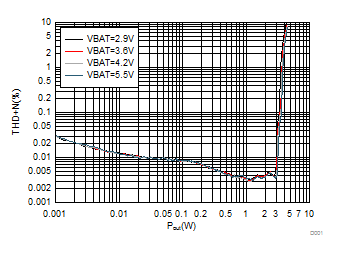
| 8 Ω + 33 µH | Freq = 1 kHz |
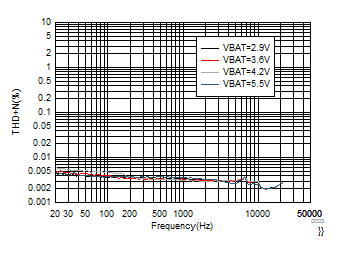
| 8 Ω + 33 µH | POUT = 1 W |
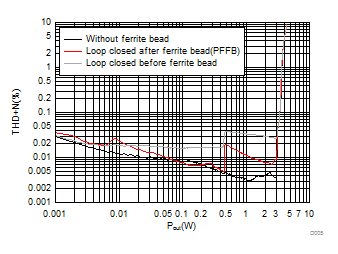
| 8 Ω + 33 µH | Freq = 1 kHz |
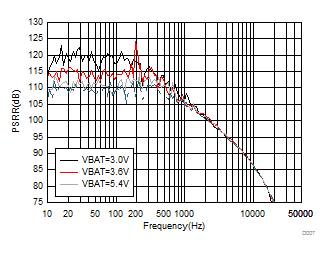
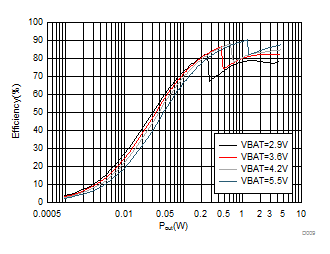
| 8 Ω + 33 µH | SSM Mode | |||

| 8 Ω + 33 µH | SSM Mode | |||
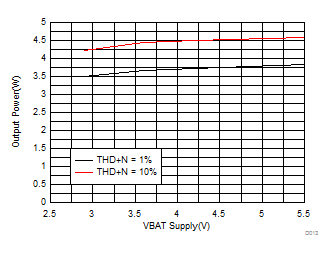
| 8 Ω+ 33 µH |
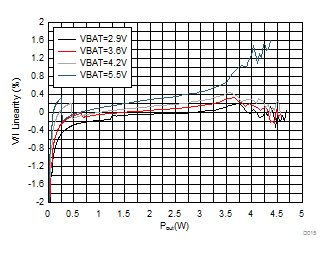
| 8 Ω + 33 µH |
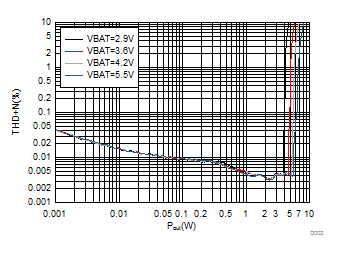
| 4 Ω + 16 µH | Freq = 1 kHz |
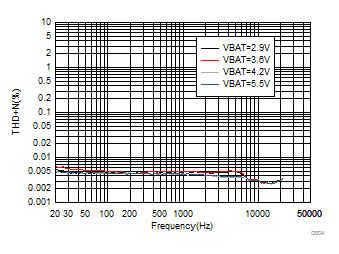
| 4 Ω + 16 µH | POUT = 1 W |
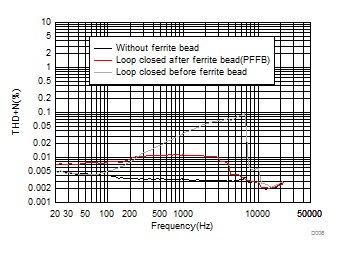
| 8 Ω + 33 µH | POUT = 1 W |
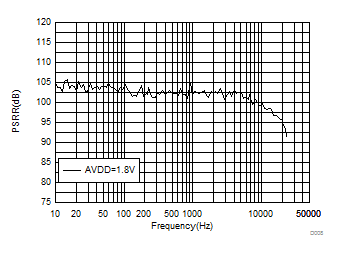
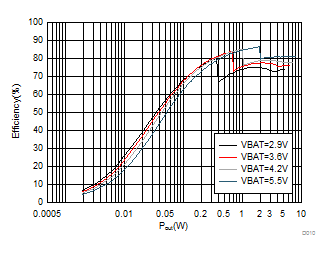
| 4 Ω + 16 µH | SSM Mode | |||
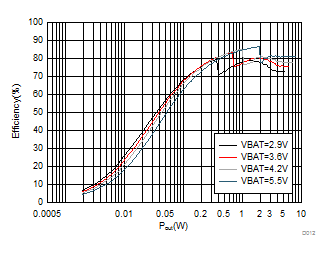
| 4 Ω + 16 µH | SSM Mode | |||
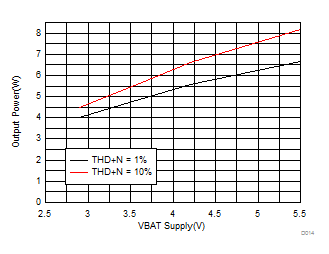
| 4 Ω+ 16 µH |
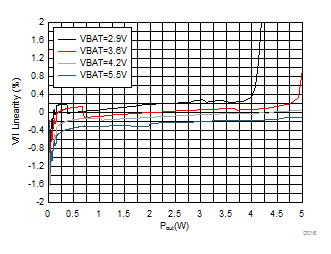
| 4 Ω+ 16µH |